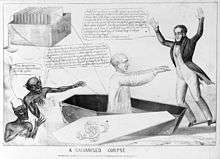Galvanism


In biology, galvanism is the contraction of a muscle that is stimulated by an electric current. In physics and chemistry, it is the induction of electrical current from a chemical reaction, typically between two chemicals with differing electronegativities.
History
The effect was named after the scientist Luigi Galvani, who became one of the most brilliant scientists in the 18th century with his research and experiments of his theory on animal electricity. He investigated the effect of electricity on dissected animals in the 1780s and 1790s. His theory was respected by many scientists, but not by Alessandro Volta, who thought that Luigi was confused about his theory. However, Galvani was able to show proof of each of his arguments and win the fight against Volta. Galvani's theories were confirmed by scientists to give him the status as the father of electrophysiology. "This debate would result in the creation of electrophysiology, electromagnetism, electrochemistry and the electrical battery."[2]
On March 27, 1791, Galvani published a book about his work on animal electricity. It contained comprehensive details of his 11 years of research and experimentation on the topic. The book provided a gateway for the public to learn about groundbreaking scientific research at the time.[3]
When Galvani was doing some dissection work in his lab, his scalpel touched the body of a frog, and he saw the muscles in the frog's leg twitch. Galvani referred to the phenomenon as animal electricity, believing that he had discovered a distinct form of electricity. His nephew Giovanni Aldini's most famous public demonstration of the electro-stimulation technique of deceased limbs was performed on the executed criminal George Foster at Newgate in London in 1803.[4][5] The Newgate Calendar describes what happened when the galvanic process was used on the body:
On the first application of the process to the face, the jaws of the deceased criminal began to quiver, and the adjoining muscles were horribly contorted, and one eye was actually opened. In the subsequent part of the process the right hand was raised and clenched, and the legs and thighs were set in motion.[6]
Modern studies
The modern study of galvanic effects in biology is called electrophysiology, the term galvanism being used only in historical contexts. The term is also used to describe the bringing to life of organisms using electricity, as popularly associated with, but only explicitly stated in the 1831 revised edition of, Mary Shelley's work Frankenstein, and people still speak of being "galvanized into action".
See also
- Electrohomeopathy
- Bioelectromagnetics
- Electrotherapy
- Electrotherapy (cosmetic)
- Frankenstein
- Hallerian physiology, for a counter-theory to Galvanism
References
- ↑ David Ames Wells, The science of common things: a familiar explanation of the first principles of physical science. For schools, families, and young students., Publisher Ivison, Phinney, Blakeman, 1859, 323 pages (page 290)
- ↑ Cajavilca, Christian, Joseph Varon, and George L. Sternbach. "Luigi Galvani and the Foundations of Electrophysiology." Resuscitation, vol. 80, no. 2, 2009., pp. 159-162doi:10.1016/j.resuscitation.2008.09.020.
- ↑ Montillo, Roseanne. The Lady and her Monsters. Harper Collin. pp. 49-50.
- ↑ "AIM25 text-only browsing: Royal College of Surgeons of England: Aldini, Giovanni: Notebook". Aim25.ac.uk. Retrieved 2012-08-05.
- ↑ "Early Nineteenth century electrochemistry". Retrieved 21 October 2010.
- ↑ The Newgate Calendar - George Foster Executed at Newgate, 18th of January, 1803, for the Murder of his Wife and Child, by drowning them in the Paddington Canal; with a Curious Account of Galvanic Experiments on his Body